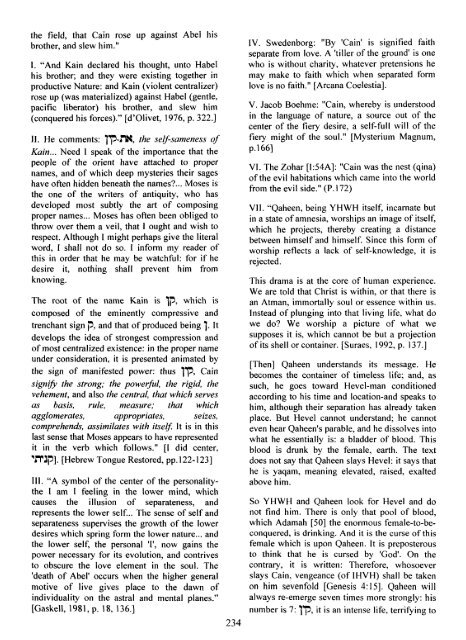Gematria - Sepher Sapphires Volume 1.pdf
Gematria - Sepher Sapphires Volume 1.pdf
Gematria - Sepher Sapphires Volume 1.pdf
You also want an ePaper? Increase the reach of your titles
YUMPU automatically turns print PDFs into web optimized ePapers that Google loves.
the field, that Cain rose up against Abel his<br />
brother, and slew him."<br />
I. "And Kain declared his thought, unto Habel<br />
his brother; and they were existing together in<br />
productive Nature: and Kain (violent centralizer)<br />
rose up (was materialized) against Habel (gentle,<br />
pacific liberator) his brother, and slew him<br />
(conquered his forces)." [d'olivet, 1976, p. 322.1<br />
11. He comments: IT-PN, the self-sameness of<br />
Kain ... Need I speak of the importance that the<br />
people of the orient have attached to proper<br />
names, and of which deep mysteries their sages<br />
have often hidden beneath the names? ... Moses is<br />
the one of the writers of antiquity, who has<br />
developed most subtly the art of composing<br />
proper names... Moses has often been obliged to<br />
throw over them a veil, that I ought and wish to<br />
respect. Although I might perhaps give the literal<br />
word, I shall not do so. I inform my reader of<br />
this in order that he may be watchful: for if he<br />
desire it, nothing shall prevent him from<br />
knowing.<br />
The root of the name Kain is fi), which is<br />
composed of the eminently compressive and<br />
trenchant sign p, and that of produced being f. It<br />
develops the idea of strongest compression and<br />
of most centralized existence: in the proper name<br />
under consideration, it is presented animated by<br />
the sign of manifested power: thus IT, Cain<br />
signijj the strong; the powerful, the rigid, the<br />
vehement, and also the central, that which serves<br />
as basis, rule, measure; that which<br />
agglomerates, appropriates, seizes,<br />
comprehends, assimilates with itself: It is in this<br />
last sense that Moses appears to have represented<br />
it in the verb which follows." [I did center,<br />
'rrl?]. [Hebrew Tongue Restored, pp. 122- 1231<br />
111. "A symbol of the center of the personalitythe<br />
I am I feeling in the lower mind, which<br />
causes the illusion of separateness, and<br />
represents the lower self. .. The sense of self and<br />
separateness supervises the growth of the lower<br />
desires which spring form the lower nature ... and<br />
the lower self, the personal '1', now gains the<br />
power necessary for its evolution, and contrives<br />
to obscure the love element in the soul. The<br />
'death of Abel' occurs when the higher general<br />
motive of live gives place to the dawn of<br />
individuality on the astral and mental planes."<br />
[Gaskell, 1981, p. 18, 136.1<br />
234<br />
1V. Swedenborg: "By 'Cain' is signified faith<br />
separate from love. A 'tiller of the ground' is one<br />
who is without charity, whatever pretensions he<br />
may make to faith which when separated form<br />
love is no faith." [Arcana Coelestia].<br />
V. Jacob Boehme: "Cain, whereby is understood<br />
in the language of nature, a source out of the<br />
center of the fiery desire, a self-full will of the<br />
fiery might of the soul." [Mysterium Magnum,<br />
p.1663<br />
VI. The Zohar [1:54A]: "Cain was the nest (qina)<br />
of the evil habitations which came into the world<br />
from the evil side." (P. 172)<br />
VII. "Qaheen, being YHWH itself, incarnate but<br />
in a state of amnesia, worships an image of itself,<br />
which he projects, thereby creating a distance<br />
between himself and himself. Since this form of<br />
worship reflects a lack of self-knowledge, it is<br />
rejected.<br />
This drama is at the core of human experience.<br />
We are told that Christ is within, or that there is<br />
an Atman, immortally soul or essence within us.<br />
Instead of plunging into that living life, what do<br />
we do? We worship a picture of what we<br />
supposes it is, which cannot be but a projection<br />
of its shell or container. [Suraes, 1992, p. 137.1<br />
[Then] Qaheen understands its message. He<br />
becomes the container of timeless life; and, as<br />
such, he goes toward Hevel-man conditioned<br />
according to his time and location-and speaks to<br />
him, although their separation has already taken<br />
place. But Hevel cannot understand; he cannot<br />
even hear Qaheen's parable, and he dissolves into<br />
what he essentially is: a bladder of blood. This<br />
blood is drunk by the female, earth. The text<br />
does not say that Qaheen slays Hevel: it says that<br />
he is yaqam, meaning elevated, raised, exalted<br />
above him.<br />
So YHWH and Qaheen look for Hevel and do<br />
not find him. There is only that pool of blood,<br />
which Adamah [50] the enormous female-to-be-<br />
conquered, is drinking. And it is the curse of this<br />
female which is upon Qaheen. It is preposterous<br />
to think that he is cursed by 'God'. On the<br />
contrary, it is written: Therefore, whosoever<br />
slays Cain, vengeance (of IHVH) shall be taken<br />
on him sevenfold [Genesis 4:15]. Qaheen will<br />
always re-emerge seven times more strongly: his<br />
number is 7: f p, it is an intense life, terrifying to


